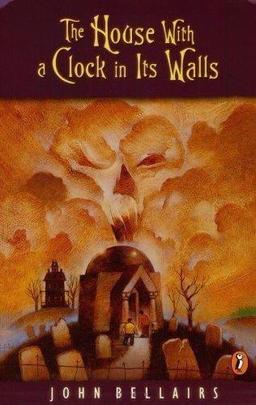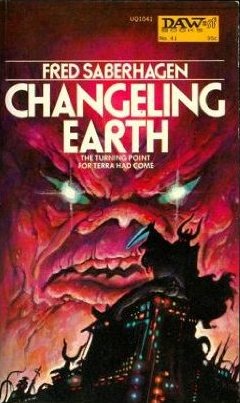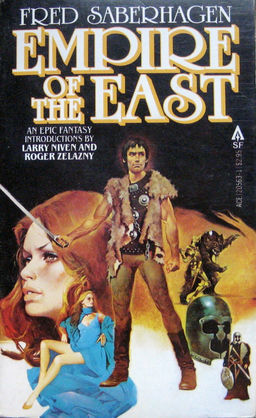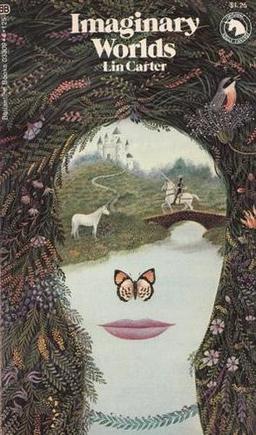John Bellairs, Fred Saberhagen and Appendix N: Advanced Readings in D&D
 I know John Bellairs mostly as the author of a host of YA fantasy mysteries — rather dark fantasy mysteries, actually, with a twinge of horror. The first one I purchased was The House With a Clock in its Walls, back when my kids were very young, but I imagined they’d thank me as they grew older and started devouring the fantasy library I’d diligently built for them.
I know John Bellairs mostly as the author of a host of YA fantasy mysteries — rather dark fantasy mysteries, actually, with a twinge of horror. The first one I purchased was The House With a Clock in its Walls, back when my kids were very young, but I imagined they’d thank me as they grew older and started devouring the fantasy library I’d diligently built for them.
Never happened. Instead, they did the exact same thing I did at their age: found their own books and steadfastly ignored the stuff their boring parents kept recommending.
They read Christopher Paolini’s Eragon series, and Suzanne Collins’s Gregor books, John A. Flanagan’s Ranger’s Apprentice, and Suzanne Collins’s Hunger Games. I ended up with stacks of unread John Bellairs titles like The Eyes of the Killer Robot and The Spell of the Sorcerer’s Skull. At least they looked good on the shelves.
John Bellairs also wrote at least one adult fantasy, The Face in the Frost. And that was apparently enough to win him a space in Gary Gygax’s Appendix N in the back of the Dungeon Masters Guide, which is why we’re talking about him today.
Mordicai Knode and Tim Callahan are examining one Appendix N writer per week at Tor.com, in their Advanced Readings in D&D series. They’ve done 15 installments so far, and for number 16 Tim turns to John Bellairs.
But first, he briefly returns to subject #15, Lin Carter, to say a few words about his exceptional treatise on adult fantasy, Imaginary Worlds.
The Face in the Frost, by John Bellairs… is one of the novels Gary Gygax specifically mentioned by name, and its greatest claim to close-to-fame is that Lin Carter named it one of the three “best fantasy novels to appear since The Lord of the Rings” in his detailed survey of fantasy fiction called Imaginary Worlds…
But if I can take a detour here for a minute… then I think it’s worth mentioning that Imaginary Worlds, in addition to its ringing endorsement for the Bellairs novel, has plenty to recommend it to the Appendix N fans among us. Imaginary Worlds is something akin to a 1973 paperback version of Advanced Readings in Dungeons & Dragons written by an unabashed fantasy enthusiast who also happened to be a pretty good fantasy author himself. And it came out the year before Dave Arneson and Gary Gygax released the first iteration of D&D. But Lin Carter’s non-fiction tour through fictional fantasy ends up providing some fascinating context for many of the writers and works that would later appear in Gygax’s Appendix N… I wouldn’t go so far as to say that Imaginary Worlds is some kind of secret decoder ring for Appendix N readers, but it is definitely worth your time…
Coincidentally, I was dipping into Imaginary Worlds just last week, as I was looking through Carter’s Adult Fantasy series for duplicates I could give away. I can confirm Tim’s appraisal: it’s a delightful book with much to reward any reader looking for fine recommendations.
But let’s get back to the real subject of our column, John Bellairs, who managed with a single novel what a great many fantasy writers failed to accomplish in their whole career: finagle a mention on Appendix N.
Other than the Jack Vance books, this is probably the most wizardy of all the Appendix N volumes… [Bellairs] wanted to play around in the genre, specifically with a Gandalf-like character because he found Tolkien’s Gandalf to be relatively flat. So if you approach The Face in the Frost as an attempt at writing a more fully-realized wizard, you’ll be in the right frame of mind. And if you approach the novel as an attempt to write a wizard buddy comedy with the looming threat of another, mostly unseen, wizard, then you’re really on the right track.
This Bellairs novel is like Gandalf and Gandalf teaming up to fight an invisible Gandalf. Sort of…
Bellairs does give us a really cool sequence where Prospero tries to thwart an invading army by destroying a stone bridge with his magic. Only, he realizes that he has no idea how to destroy a stone bridge, and he tries to use some Tarot cards and some chanting and nothing seems to work until he unleashes a fury of cards and magical commands and, well, it gets messy.
That’s surely the kind of stuff that influenced Gygax and earned The Face in the Frost a place on the hallowed shelves of Appendix N. The magic is messy in this book. It often doesn’t work, or doesn’t work as intended, and even when it does work, it’s not the sort of magic that’s super-powerful wizard laser beams or massive fireballs. It’s cantrip-type stuff. Enchanted mirrors. Little magical trinkets. Making notes and drawings in books. Trying to find the card and the right word that makes the stone bridge go boom.
 The Face in the Frost was John Bellairs’ third novel, and one of his only novels for adult readers. It was published in hardcover in 1969 by Macmillan, and reprinted in a popular paperback edition by Ace in 1981.
The Face in the Frost was John Bellairs’ third novel, and one of his only novels for adult readers. It was published in hardcover in 1969 by Macmillan, and reprinted in a popular paperback edition by Ace in 1981.
Although Tim doesn’t mention it, the wizard Prospero’s nightly practice of studying his spell book to prepare his spells is sometimes said to have inspired D&D‘s similar spell mechanic.
Read Tim’s complete column here.
With column 17, Tim turns to Fred Saberhagen, and specifically the third novel in his four-volume Empire of the East saga, Changeling Earth (1973), which followed The Broken Lands (1968) and The Black Mountains (1971), and preceded the final volume, Ardneh’s Sword (2006), by some 25 years.
Gary Gygax mentions no other Fred Saberhagen book by name, but he includes Changeling Earth on his list. It’s even on the proto-Appendix N that Gygax published in the fourth issue of The Dragon magazine. For some reason, he loved Changeling Earth above all. Let’s try to figure out why…
The whole thing takes place 50,000 years into our own future, and Saberhagen lingers on the troop movements and leadership-decision-making, but it’s undoubtedly a fantasy novel. Magic has replaced technology, mostly… the god-like power that watches over the East, and sometimes intervenes or seems to intervene, the force that powers the Eastern armies towards what could be a confident victory over the West…well, it’s WOPR.
You know, WOPR! From WarGames!… Or a sentient version of WOPR, called Ardneh.
Ardneh, who is basically an energy being with psychic powers, evolved from AUTOMATED RESTORATION DIRECTOR — NATIONAL EXECUTIVE HEADQUARTERS. … Ardneh is the East’s guiding light and secret weapon. But the West has its own super-powerful force in the form of Orcus. Yes, Orcus, that classic D&D demon in his Saberhagen-drenched form of… get this… a nuclear explosion that was frozen in mid-explosion and then chained underground by the Western forces that would attempt to control it. Orcus is a nuclear power, contained. It’s only a matter of time before he is unleashed and the exploding-bombiness of Orcus vs. the super-electro-psionics of Ardneh reach an intense climax.
 Although Tim doesn’t mention it, Changeling Earth was later heavily revised by Saberhagen and re-titled Ardneh’s World.
Although Tim doesn’t mention it, Changeling Earth was later heavily revised by Saberhagen and re-titled Ardneh’s World.
The first three volumes — The Broken Lands, The Black Mountains, and the revised Ardneh’s World — were collected in a single omnibus edition in 1979 by Ace, titled Empire of the East.
Ardneh’s World was also published as a standalone paperback by Tor in May, 1988, and the final volume, Ardneh’s Sword, was released by Tor in May 2006.
Empire of the East also forms a Future History prelude to Sabergahegn’s popular 11-volume Swords series, which is set in the aftermath of the apocalyptic showdown between ARDNEH and Orcus. Here’s a concise summary of events from the Wikipedia entry on Sabergahegn’s Books of Swords (warning: some spoilers).
Approximately 50,000 years before the story, sometime during our third millennium, mankind is almost driven to extinction by a global apocalypse. This is explained as being brought on by a nuclear World War prior to the events in Empire of the East. An intelligent super-computer, ARDNEH, part of a former American nuclear response system, initiated a physical change to the structure of the world. Unintentionally combined with a similar system on the other side of the world, this change negated the effects of atomic weaponry and most other forms of high technology, and introduced other side-effects, such as the creation of magic, gods, and demons. ARDNEH then continued to stabilize and sustain humanity through the ensuing Dark Ages. ARDNEH was destroyed millennia before the events of the series, as chronicled in Saberhagen’s Empire of the East series. By the time the events recorded in The Books of the Swords occur, ARDNEH has passed into legend, worshipped as a benevolent god.
Read Tim’s complete Saberhagen column here.
We last covered Mordicai and Tim’s journey into Appendix N on September 24th, when they discussed Jack Williamson and Lin Carter. The complete list of authors they’ve covered includes:
Leigh Brackett and J.R.R. Tolkien
Margaret St. Clair and Andrew Offutt
Lord Dunsany and Philip José Farmer
H.P. Lovecraft and A. Merritt
Manly Wade Wellman and Fletcher Pratt
Fredric Brown and Stanley G. Weinbaum
John Bellairs and Fred Saberhagen
Jack Williamson and Lin Carter
Andre Norton and Michael Moorcock
L. Sprague de Camp, Fletcher Pratt, and Gardner Fox
Roger Zelazny and August Derleth
Jack Vance
Fritz Leiber and Edgar Rice Burroughs
Sterling E. Lanier
Poul Anderson
Robert E. Howard
See the complete list of authors they’ve covered so far here.
Next up: Fredric Brown and the great Stanley G. Weinbaum.

Empire of the East is an enjoyable read, it’s one of my two favorite Saberhagen titles (the other being Berserker, of course).
Thanks for this! FACE IN THE FROST is now on my must-read list. As is EMPIRE OF THE EAST…
Face in the Frost has been waiting on my shelf for far too long; and I’ve read a bunch of the Swords/Lost Swords books, but never Empire of the East. (When the Swords books first started coming out, I didn’t realize they were tied to a previous series.)
And yeah, delightful is a good word for Imaginary Worlds — I’ve always enjoyed Lin Carter’s unbridled enthusiasm for the genre.
> Empire of the East is an enjoyable read, it’s one of my two favorite Saberhagen titles (the other being Berserker, of course).
Eric,
I should have mentioned Fred’s BERSERKER novels. That was an oversight. I debated giving a plug for his SWORDS books, but decided against it because I hadn’t read any.
> Thanks for this! FACE IN THE FROST is now on my must-read list. As is EMPIRE OF THE EAST…
John,
You are most welcome. Thank Tim and Mordicai — they did all the heavy lifting. 🙂
And if you have a chance to sample either, drop by here to let us know what you think.
> And yeah, delightful is a good word for Imaginary Worlds — I’ve always enjoyed Lin Carter’s unbridled enthusiasm for the genre.
Joe,
I think Lin Carter reintroduced a great many fantasy classics to a whole new generation. He released one new Adult Fantasy novel a month, like clockwork, for over five years. His contributions are sadly overlooked these days.
Much like my Night Shade Kane books, you’ll get my Ballantine Adult Fantasy collection when you pry it from my cold, dead fingers.
I love Empire of the East. It’s one of those classics with a fun, semi-off-the-cuff feel to its world-building, which is fine and let’s the story be a story unburdened.
My new year’s reading resolution is to include a lot more Saberhagen next year. I need to read more of his work.
> I love Empire of the East. It’s one of those classics with a fun, semi-off-the-cuff feel to its world-building
Paul,
Well said. Speaking of world-building, I should have pointed out the way EMPIRE OF THE EAST eventually formed the backstory to Saberhagen’s BOOK OF SWORDS (I wasn’t even aware of the connection myself until recently).
I went ahead and inserted a new paragraph to that effect at the end.
James Stoddard wrote a wonderful little tribute to Lin Carter and the Ballantine Adult Fantasy line for MZB Magazine back in 1994. We reprinted it in MOOREEFFOC a few years later, but it is also posted online — with reproductions of some of the great Ballantine covers — here:
http://www.beyond49.ca/Carter/stoddard_trib.html
I remember The Face in the Frost being a fun read. The House With the Clock in its Walls and some of its sequels are great kid spook stories. There’s an adaptation of House featuring the always fun Severn Darden and narrated by Vincent Price.
John Bellairs.
Really, what more need be said?
Not a High Fantasy kind of guy, but boy did he come up with some spooky material for teen readers — and beyond.
I repeat.
John. Bellairs.
Nick,
That’s a great article! Thanks for the link.
You should share more of the greatness that was MOOREEFFOC here. A sadly neglected, great little zine.
> There’s an adaptation of House featuring the always fun Severn Darden and narrated by Vincent Price.
Fletcher,
Um, what?
Is that a movie? I had no idea.
> Not a High Fantasy kind of guy, but boy did he come up with some spooky material for teen readers — and beyond.
Mark,
I’ve been looking for someone who could speak with authority on Bellairs YA material. Your timing is excellent.
I was hoping to recruit them to do an article for us. How convenient that you already have a bi-weekly blog slot. Hint hint.
My work here is done.
The right word to make the bridge go boom? I seem to remember a situation like that from a certain episodic James Enge novel.
And now I clearly need to read The Face in the Frost.
[…] well as Mordicai Knode and Tim Callahan, who are examining one Appendix N writer per week in their Advanced Readings in D&D series at Tor.com — that style of play was very much influenced by classic heroic fantasy and […]
[…] last covered Mordicai and Tim’s journey into Appendix N on September 24th, when they discussed John Bellairs and Fred Saberhagen. The complete list of authors they’ve covered […]
[…] 1973: Changeling Earth, aka Ardneh’s World, by Fred Saberhagen, is published. (Possible inspirations for D&D include Orcus, extra-planar monsters, arch-mages, and the ethos of lawful […]